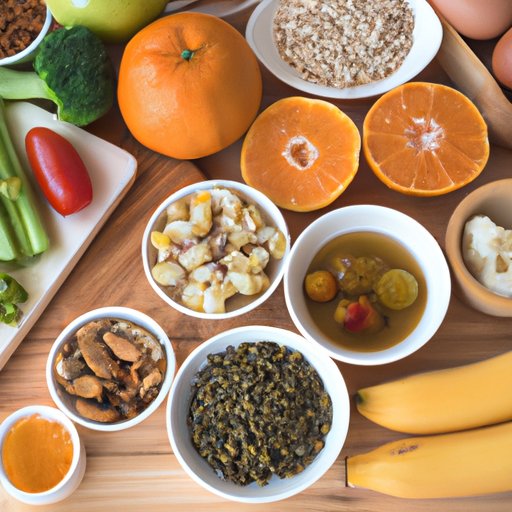
Introduction
High cholesterol is a common health concern that affects millions of people worldwide. It occurs when there are high levels of fat or cholesterol in the blood, leading to health issues such as heart disease, stroke, and high blood pressure. In this article, we will explore the most effective diet plans for managing high cholesterol levels. Eating a balanced diet is a crucial step in managing high cholesterol levels and improving overall health and wellbeing.
Foods That Naturally Lower High Cholesterol
While some foods can cause high levels of cholesterol, there are others that can help lower it. Seven foods that are known to lower high cholesterol include avocado, garlic, legumes, nuts, olive oil, soy, and whole grains. These foods contain nutrients that help reduce triglycerides, LDL cholesterol, and total cholesterol levels in the body. To incorporate these foods into a balanced diet plan, try adding a chopped avocado to your salad, mixing nuts into your cereal or yogurt, and cooking with olive oil instead of butter.

How Fatty Fish and Nuts Can Help Lower Your Cholesterol Levels
Fatty fish and nuts are also effective in reducing high cholesterol levels. These foods contain high levels of omega-3 fatty acids that help reduce inflammation in the body, improve blood vessel health, and lower triglycerides in the blood. To include fatty fish and nuts in your diet, try adding salmon or tuna to your salad, making a trail mix with nuts, or swapping your regular cooking oil with walnut oil.
The Connection Between Fiber and Cholesterol Reduction
Fiber is a crucial nutrient for cholesterol control. Soluble fiber, in particular, binds to cholesterol in the digestive system and prevents it from being absorbed into the bloodstream. Fiber-rich foods include fruits, vegetables, whole grains, legumes, and nuts. To add fiber to your diet, try swapping white bread for whole-grain bread, adding fresh berries or nuts to your cereal, and snacking on raw veggies with hummus or salsa.
The Benefits of Including Fresh Fruits and Vegetables In Your Diet for Cholesterol Control
Fresh fruits and vegetables contain essential nutrients that help reduce high cholesterol levels and improve overall health. These foods contain antioxidants that help lower blood pressure and inflammation, leading to a reduced risk of heart disease. To incorporate fresh fruits and vegetables into your diet, try adding fresh berries to your oatmeal, making a smoothie with mixed fruits and veggies, and adding fresh greens to your sandwich or wrap.
The Role of Whole Grains in Lowering Cholesterol
Whole grains, such as brown rice, quinoa, and whole-wheat bread, are an excellent source of fiber and other essential nutrients that help lower cholesterol levels. These foods contain soluble fiber, which helps reduce the absorption of cholesterol into the bloodstream. To add whole grains to your diet, try making a brown rice bowl with mixed veggies and grilled chicken, adding quinoa to your salad, or making a whole-grain wrap with spinach and hummus.
Healthy Fats vs. Unhealthy Fats and Their Impact on Cholesterol
It’s essential to understand the difference between healthy and unhealthy fats when creating a diet plan for high cholesterol management. Healthy fats, such as those found in nuts, seeds, oily fish, and avocado, have a positive impact on cholesterol levels and overall health. Unhealthy fats, such as trans fats and saturated fats, can raise unhealthy cholesterol levels and increase the risk of heart disease. To incorporate healthy fats into your diet, try adding a handful of nuts or seeds to your salad, eating salmon or tuna twice a week, or adding sliced avocado to your sandwich or wrap.
A Comprehensive Guide to Creating a Cholesterol-Friendly Diet Plan
Creating a healthy diet plan for managing high cholesterol levels involves consuming a balanced mix of all essential nutrients. It’s essential to include foods that lower cholesterol levels while minimizing or eliminating foods that raise it. Creating a personalized diet plan can also help maintain overall health and wellbeing. When creating a diet plan, be sure to include a mix of fruits, veggies, healthy fats, whole grains, and lean proteins such as chicken, fish, and legumes. Limit your intake of saturated fats and processed foods, and drink plenty of water to stay hydrated.
Conclusion
Managing high cholesterol levels is a critical step in maintaining good health and preventing chronic diseases such as heart disease and stroke. A healthy diet plan is an effective way to manage high cholesterol levels, and regularly consuming foods that naturally lower cholesterol levels can significantly improve overall health and wellbeing. By incorporating fresh fruits and vegetables, whole grains, healthy fats, and lean proteins into your diet, you will be taking a crucial step in maintaining good health and preventing chronic diseases.




